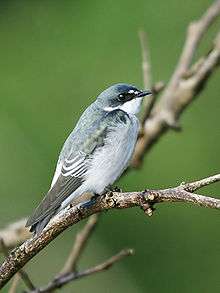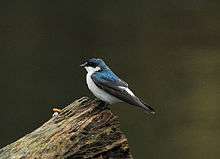Mangrove swallow
| Mangrove swallow | |
|---|---|
 | |
| Scientific classification | |
| Kingdom: | Animalia |
| Phylum: | Chordata |
| Class: | Aves |
| Order: | Passeriformes |
| Family: | Hirundinidae |
| Genus: | Tachycineta |
| Species: | T. albilinea |
| Binomial name | |
| Tachycineta albilinea (Lawrence, 1863) | |
 | |
The mangrove swallow (Tachycineta albilinea) is a passerine bird that breeds in coastal regions from Mexico through Central America to Panama. It is non-migratory, but may make seasonal movements. It is classified as least concern.
Taxonomy and etymology
The mangrove swallow was formally described in 1863 as Petrochelidon albilinea by American amateur ornithologist George Newbold Lawrence.[2] The new genus Tachycineta was created for this group of swallows by German ornithologist Jean Cabanis in 1850.[3] The current genus name Tachycineta, is from Ancient Greek takhukinetos, "moving quickly", and the specific albilinea is from Latin albus, "white", and linea, "line".[4]
The Tachycineta species are members of the swallow family of birds, and are placed in the Hirundininae subfamily, which comprises all swallows and martins except the very distinctive river martins. DNA sequence studies suggest that there are three major groupings within the Hirundininae, broadly correlating with the type of nest built.[5] These groups are the "core martins", including burrowing species like the sand martin, the "nest-adopters", which are birds that utilise natural cavities, and the "mud nest builders" such as the Delichon house martins. The Tachycineta species belong to the "nest-adopter" group.[6]
All nine Tachycineta species have glossy blue or green backs and white underparts, but the five species with white rumps, the mangrove swallow, Tumbes swallow, white-winged swallow, white-rumped swallow and Chilean swallow are particularly closely related, the first three and the last two forming two superspecies. The Tumbes swallow was formerly considered to be a subspecies of the mangrove swallow, but its calls, behaviour and cytochrome b data confirm it to be a full species.[7] It is also differentiated from the mangrove swallow by its lack of a supraloral white line and by its slight difference in size.[8]
Description
The mangrove swallow, a relatively small swallow, averages 13 centimetres (5.1 in) long and weighs about 14 grams (0.49 oz). The bill is small and black, about 11 millimetres (0.43 in) long. The adult mangrove swallow has iridescent blue-green upperparts, white underparts, rump, and undertail- and wing-coverts, and blackish tail and flight feathers. The feathers transition from its most green when fresh to blue with wear. The white underparts sometimes have faint, dark shaft streaks.[9] Its lores are black and have a thin, white line above them. The adult's tail is, on average, 42 millimetres (1.7 in) long. The tail is only slightly forked, and the fork measures about 5 millimetres (0.20 in) on average. The female has a slightly longer tail on average, 42 millimetres (1.7 in), compared to 40.8 millimetres (1.61 in) for the male. Another difference between the male and the female is that the female has a slightly shorter wingspan than the male, an average of 97.5 millimetres (3.84 in) for the male and an average of 94.7 millimetres (3.73 in) for the female. The juvenile is dull grey-brown above and grey-brown washed white below.[9][10] Occasionally, the juvenile's upperparts have a subtle, greenish gloss.[8]
They are very similar to Tumbes swallow (Tachycineta stolzmanni), of coastal Peru. Tumbes swallow is differentiated from the mangrove swallow by its lack of white stripes above its eyes.[9][8]
The call of the mangrove swallow is a rolled "jeerrrt", or a "chriet".[10] The song is frequently described as a soft trilling.[9][10][8]
Distribution
This swallow is native to Belize, Costa Rica, El Salvador, Guatemala, Honduras, Mexico, Nicaragua, Panama, and Peru. They usually are found near low-lying bodies of water and mangrove forests, which is where this swallow gets its name from. They have also been recorded to reside in intertidal zones. In Mexico, they are not usually found above 600 metres (2,000 ft).[1] In Costa Rica, they have been found to occur as high as 1,000 metres (3,300 ft), but they normally occur between 500 metres (1,600 ft) and sea level. They are rarely found in the high-lands. The mangrove swallow is also vagrant to the United States. It was first recorded in the United States in 2002, in Florida.[11]
Behaviour

Breeding
The mangrove swallow’s bulky cup nest is built in natural or artificial cavities near water. The nest is a few centimetres deep and made with grass, fine stems, moss, and a few leaves and sticks. It is padded with feathers. Their nests are usually found to occur below 2 metres (6.6 ft). While their nests are built relatively low, it is still usually above the water level of a flood.[8] Sites include tree holes and crevices in rock or bridges. Nests are not found closer than 50 metres (160 ft) away from each other, and usually have about 300 metres (980 ft) separating them. In addition to this, the mangrove swallow is solitary.[9]
The mangrove swallow is a seasonal breeder. Its breeding season is about five months.[12] The data suggests that the breeding season is from approximately January to July in central America, and from around March to June or July in Mexico.[9][8] Like the related tree swallow, this species is very aggressive to other hirundines when breeding and is very territorial.[9]
The clutch is three to five white eggs which hatch in 17 days. The nestlings are fed by both parents for 23–27 days to fledging.[9][8]
Although the mangrove swallow is a full time resident of its range, there are probably some post-breeding movements.[10][8]
This species is closely associated with fairly still open water, and is often found in small flocks over rivers or lakes when not breeding.[11] As such, their flight paths are usually direct and low over water. The mangrove swallow also frequently perches.[12][13]
Diet
The mangrove swallow subsists primarily on a diet of small, flying insects, including large species such as dragonflies and bees.[13][14] It usually feeds close over bays, lakes, and large rivers, but sometimes can be found to forage 30 metres (98 ft) or more above the water.[9][14] They normally forage in small flocks or pairs.[13]
Mangrove swallows forage close to their nest when they are foraging for the nestlings. When foraging for nestlings, they usually stay within about 100 metres (330 ft) of their nest. But, when hunting for themselves, they have been recorded to go as far out as 200 metres (660 ft) from their nest.[9][15]
Status
As of 2012, the mangrove swallow is classified as "Least Concern" by the IUCN. The IUCN does mention, although, that the population seems to be decreasing. This is probably due to habitat loss or pesticides.[1][9] A justification for classifying it as "Least Concern" is its large population, estimated to be larger than 500,000 individuals.[16]
References
- 1 2 3 BirdLife International (2012). "Tachycineta albilinea". IUCN Red List of Threatened Species. Version 2013.2. International Union for Conservation of Nature. Retrieved 26 November 2013.
- ↑ Lawrence, George Newbold Lawrence (1863). "Catalogue of a Collection of Birds, made in New Granada, by James McLeannan, Esq., of New York, with Notes and Descriptions of New Species. Part IV". Annals of Lyceum of Natural History of New York. 8: 2.
- ↑ Cabanis, Jean (1850). Museum Heineanum : Verzeichniss der ornithologischen Sammlung des Oberamtmann Ferdinand Heine auf Gut St. Burchard vor Halberstatdt (in German). 1. Halbertstadt: Independently commissioned by R. Frantz. p. 48.
- ↑ Jobling, James A (2010). The Helm Dictionary of Scientific Bird Names. London: Christopher Helm. pp. 39, 377. ISBN 978-1-4081-2501-4.
- ↑ Sheldon, Frederick H; Whittingham, Linda A; Moyle, Robert G; Slikas, Beth; Winkler, David W (2005). "Phylogeny of swallows (Aves: Hirundinidae) estimated from nuclear and mitochondrial DNA". Molecular phylogenetics and evolution. 35 (1): 254–270. doi:10.1016/j.ympev.2004.11.008. PMID 15737595.
- ↑ Winkler, David W; Sheldon, Frederick H (1993). "Evolution of nest construction in swallows (Hirundinidae): A molecular phylogenetic perspective" (PDF). Proceedings of the National Academy of Sciences USA. 90 (12): 5705–5707. doi:10.1073/pnas.90.12.5705. PMC 46790
 . PMID 8516319.
. PMID 8516319. - ↑ Turner, Angela. del Hoyo, Josep; Elliott, Andrew; Sargatal, Jordi; Christie, David A.; de Juana, Eduardo, eds. "Family Hirundinidae: Swallows and Martins". Handbook of the Birds of the World Alive. Barcelona: Lynx Edicions. Retrieved 13 October 2016. (subscription required (help)).
- 1 2 3 4 5 6 7 8 Turner, Angela K; Rose, Chris (1989). Swallows & Martins: An Identification Guide and Handbook. Boston: Houghton Mifflin. ISBN 0-395-51174-7. p101–102
- 1 2 3 4 5 6 7 8 9 10 11 Turner, Angela (2013). del Hoyo, Josep; Elliott, Andrew; Sargatal, Jordi; Christie, David A.; de Juana, Eduardo, eds. "Mangrove Swallow (Tachycineta albilinea)". Handbook of the Birds of the World Alive. Barcelona: Lynx Edicions. Retrieved 7 November 2016. (subscription required (help)).
- 1 2 3 4 Buderman, F. E. "Identification - Mangrove Swallow (Tachycineta albilinea) - Neotropical Birds". Cornell Lab of Ornithology. Retrieved November 6, 2016.
- 1 2 Buderman, F. E. "Distribution - Mangrove Swallow (Tachycineta albilinea) - Neotropical Birds". Cornell Lab of Ornithology. Retrieved November 6, 2016.
- 1 2 Ricklefs, Robert. Foraging Behavior of Mangrove Swallows at Barro Colorado Island (PDF). p. 3. Retrieved November 6, 2016.
- 1 2 3 "Mangrove Swallow - BirdFellow Social Field Guide".
- 1 2 Ricklefs, Robert. Foraging Behavior of Mangrove Swallows at Barro Colorado Island (PDF). p. 1. Retrieved November 6, 2016.
- ↑ Ricklefs, Robert. Foraging Behavior of Mangrove Swallows at Barro Colorado Island (PDF). pp. 6–7. Retrieved November 8, 2016.
- ↑ Buderman, F. E. "Conservation - Mangrove Swallow (Tachycineta albilinea) - Neotropical Birds". Cornell Lab of Ornithology. Retrieved November 13, 2016.
